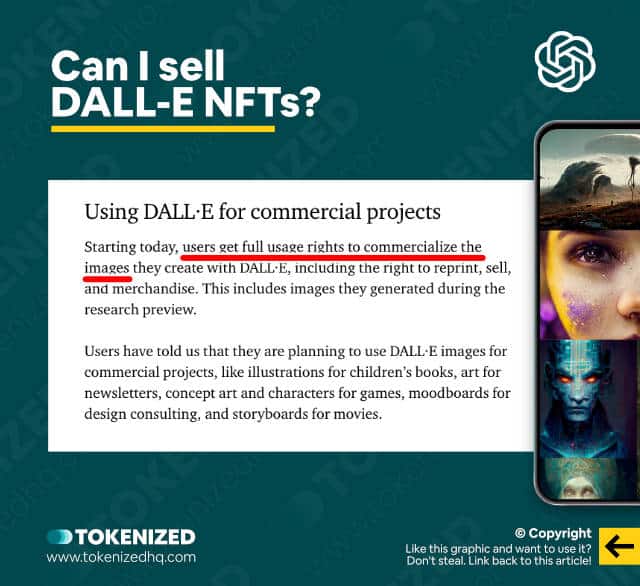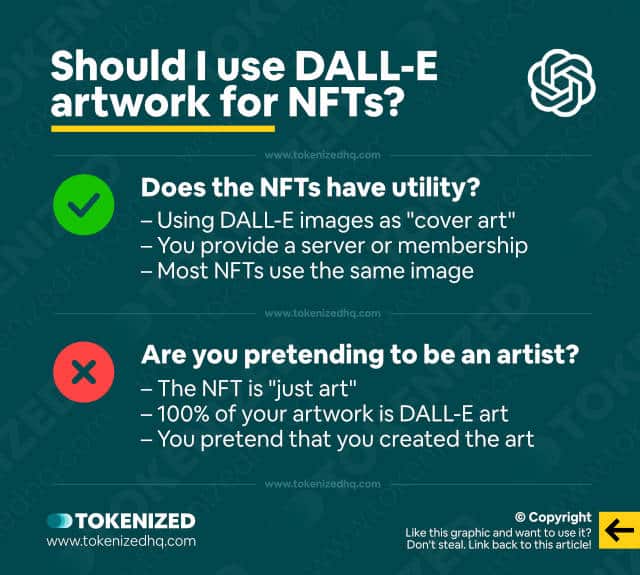Are you wondering whether you can create NFTs with DALL-E?
DALL-E NFTs probably sounds like a no-brainer to you and you probably feel like you’re pretty clever right now.
But using AI-generated artwork in order to create and sell NFTs is not only controversial but there are also quite a few legal concerns to consider.
In this guide, we’ll explain what you can and cannot do with DALL-E NFTs and why some use cases are less problematic than others.
Let’s dive right in.
Table of Contents Show
Like this content? Then share it!
Can I Legally Sell DALL-E NFTs?
www.tokenizedhq.com
Here’s the answer. Great article by @ChrisHeidorn right here: https://tokenizedhq.com/dall-e-nft/
Can I Sell DALL-E NFTs?

Even though the DALL-E terms of service do not explicitly mention the word NFTs, they explicitly permit the use of images generated in DALL-E for commercial projects.
In the overwhelming majority of cases, such commercial use will involve marketing material, cover art, media publications, printed apparel, and other merchandise.
But does this also cover the creation and sale of DALL-E NFTs?
We believe so.
Let us explain our rationale for making this claim.
First of all, the obvious question to ask is: What is an NFT anyway?
If we leave out all the imagery and fluff, NFTs are nothing but a unique tokens.
A singular entry on a blockchain that can be owned, sold and transferred to another wallet.
The image that you see on marketplaces such as OpenSea is not necessarily an inherent part of the NFT itself.
Usually, the NFT will point to an image file on a centralized server or a decentralized file system such as IPFS.
So in effect, the images on NFTs are more like the cover art of an album.
Based on this interpretation, the DALL-E license terms also cover the use of its AI-generated images for DALL-E NFTs.
The only limitation is that your DALL-E generations must abide by OpenAI’s content policy.
Most of the limitations involve obvious things, such as the fact that your artwork must be G-rated.
However, it also states that you may not use it in any way which suggests that the artwork was created entirely by a human being.
In other words, whenever you expose your generated images to the public as pieces of art, you must disclose the fact that DALL-E was used to create them.
And that also has far-reaching consequences for the permissible use of DALL-E images for NFTs.
Make sure you check out our article dedicated to DALL-E’s commercial use policy for more details.
Key Points (tl;dr)
- DALL-E’s terms of use permit the use of generated images for business purposes.
- Although NFTs are not explicitly mentioned, there are many legitimate use cases for DALL-E NFTs, especially when the image’s purpose is more akin to “cover art”.
- However, OpenAI’s content policy also sets strict boundaries that effectively prohibit anyone from claiming that their generated images were entirely created by a human being.
Should You Use DALL-E Artwork for NFTs?

There are serious ethical concerns with the use of AI-generated content.
First of all, it’s still unclear whether anything that is generated by an AI model can be deemed “original” work at all.
Since every model is trained using datasets with missions of images, one could argue that every AI-generated image contains stolen content.
But how is that different from an artist that is truly inspired by the work of another artist?
Where do you draw the line?
In reality, there’s a much more basic limitation to selling DALL-E NFTs.
OpenAI’s content policy explicitly prohibits the sharing or commercial use of images in a way that suggests that the image was created by a human being.
In other words, if you plan on selling DALL-E NFTs as works of art and want to pretend that you or another “artist” created them by yourself, then you are violating the DALL-E terms of service.
Some would even argue that you are committing fraud.
That being said, there’s nothing stopping you from selling those DALL-E NFTs as long as you make it clear to buyers that the artwork was generated with AI software.
Can I Use DALL-E for NFTs with Utility?
Despite all the controversy around intellectual property and copyright, we still believe that NFTs are an excellent use case for AI art generators.
NFTs may have started with art but their true potential lies within the multitude of potential use cases where they can provide real utility.
When the utility isn’t the art itself, then the value of the NFT lies within whatever benefits it gives you.
In such cases, the artwork becomes secondary to the intrinsic value of the NFT, which is very similar to the cover art for a music album.
The artwork is reduced to a decorative element, like a photo in a media publication.
Therefore we strongly encourage the use of DALL-E and other AI art generators for NFTs as long as you are not pretending to be an artist who is selling his work.
Frequently Asked Questions (FAQ)
Before we close off this guide, let’s quickly address some of the most common questions related to DALL-E NFTs.
-
Are we allowed to create NFTs from DALL-E artwork?
DALL-E’s terms of service explicitly permit the use of DALL-E images for business purposes. This also includes the creation of DALL-E NFTs, as long as they do not violate the OpenAI content policy. The content policy prohibits any harmful, offensive, or deceptive content and you may also not claim that the artwork was created entirely by yourself or another human being.
-
Do other AI art generators allow NFTs?
Yes, the Midjourney team has stated several times in its Discord server that artwork generated with Midjourney may be used for NFTs as well. They also have content guidelines that are similar to those of OpenAI.
Conclusion
When AI art generators hit the market in the summer of 2022, many people were quick to assume that they could make some quick and easy money with NFTs.
Now that NFTs are no longer in the spotlight, we can finally have a reasonable discussion about legitimate use cases for AI art in NFTs.
The most important thing is that we start to look at AI-generated images not necessarily as artwork for the sake of art, but rather as a tool that can enhance other products and services.
Here at Tokenized, we want to help you learn as much as possible about the AI software industry. We help you navigate the world of tech and the digitalization of our society at large, including the tokenization of assets and services.



